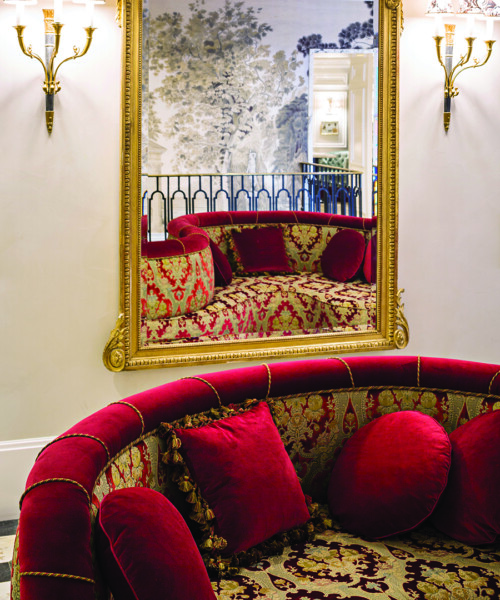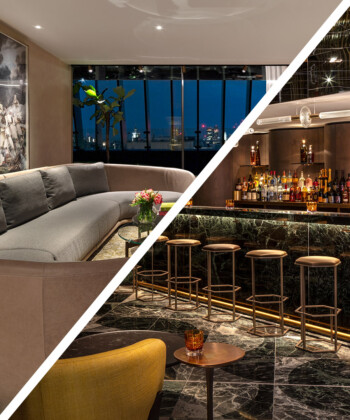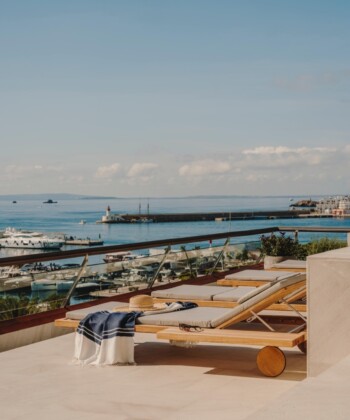When considering Parisian style, the consensus is: Anything goes. While a definitive aesthetic definition remains elusive, the following esteemed interior designers, who have just completed or are in the process of renovating historic Parisian properties, agree that Parisian style is at once unapologetic, elegant, classic, and above all, captivating. It is Paris’s combination and reverence for both old and new that, when done right, make interior style in the City of Light the envy of the world.
Fresh Face on the Left Bank
Set back on Rue Christine in Paris’s Latin Quarter hides Relais Christine, a 48-room hotel built upon the ruins of the College of the Austin Friars Abbey. Since 2015, Paris-based interior designer Laura Gonzalez of Pravda Arkitect, where she is founder and principal, has been working to renovate the entire hotel—guest rooms and suites and common areas, as well as building out the new Spa Guerlain in the limestone basement—which dates back to the 13th century. “The intention from the beginning was to keep the classic identity and also give new breath to this hotel,” says Gonzalez. “I always start with classical references for my projects, respecting the DNA of the place but twisting it with fresh things like new materials. I like to mix.”

Fabrics by Pierre Frey adorn the bedrooms at Relais Christine.
And mix she did: Gonzalez sourced the hotel’s chandeliers from Dedar for Hermès and the wallpaper from Ananbô, and paired it with furniture gathered from Parisian design markets and antique shops, along with bespoke pieces handmade by local craftspeople. The one vendor she couldn’t do without, she says, was Pierre Frey. “All of the fabrics in the bedrooms were realized with it. They have infinite colors and patterns. It is a real game and pleasure to use it. It was perfect for the color themes.”

The exterior of Relais Christine, located two minutes from the Seine.
Fit for a Prince
Designer Madelyn Byrne says the renovation of 25 Place Dauphine may have been the biggest challenge of her career, and at the same time, her largest reward. As owner and lead designer of Paris Perfect, a luxury apartment rental company with locations throughout Paris (along with sister agencies in London and Italy), she had decorated more than 70 apartments in Paris, but it was 25 Place Dauphine, a historically significant 17th-century building located at “Kilometer Zero” on Île de la Cité, that may well hold the key to her design legacy for years to come.
Considered to be one of the most beautiful squares in Paris, Place Dauphine was the first real estate development in history, with dozens of attached residences commissioned for Paris’s middle class by Henri IV. It was completed in 1610.
After two years of renovation, Byrne and her team transformed the dilapidated 17th-century building into an opulent collection of seven apartments, each with unique decor pieces, color schemes, and, thanks to the original eclectic construction, ceiling heights. Byrne frequented Paris’s Vanves Flea Market and Les Puces for pieces such as mirrors, artwork, chandeliers, and antiques, and worked with her favorite French suppliers, such as Blanc d’Ivoire, for headboards, coffee tables, and nightstands.
“I knew the renovation had to be done to save the building and to preserve its history,” Byrne says. “The day they took down the scaffolding, people from the neighboring stores and residences stood outside and clapped. To see it transformed and hear their approval, that meant everything.”

Relais Christin’s salon
Gold Standard
When the Ritz Paris closed for renovation in 2012, the city held its collective breath. Many feared a reimagined Ritz, under the vision of American artist, architect, designer, and Chevalier de la Légion d’Honneur recipient Thierry Despont, would be an altogether different hotel than the one travelers for more than a century had so publicly adored.
Guests were pleased to find that after the hotel’s four-year renovation, the Ritz’s soul remained intact. In fact, nothing in the Ritz Paris has been discarded or sold. The oak woodwork, curtains, Mareuil stone floors, gilding, decorative objects, paintings, and parquet floors had been painstakingly removed piece by piece, cataloged, and restored.
“The preservation of many small historic details was a priority,” says Despont. Returning guests will recognize swans on the bathroom fixtures, cords to call for the valet and housekeeping, old-fashioned keys for lighting, tulip lamps, and the Marthe porcelain service by Haviland, used at the Ritz Paris since its opening in 1898.

A deluxe guest room at the Relais Christine.
In addition, top ateliers won the bids for furniture restoration, and nearly all of the preexisting light fixtures, furniture, and fabrics have been returned to their original places. “Our goal was to reduce the number of rooms from 159 to 142, but most important of all, it was to optimize space and light,” he says. “Three model rooms were considered with nine color harmonies, various silks, and other fabrics. The strength of the design is due to that distinctive approach.”






































